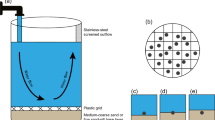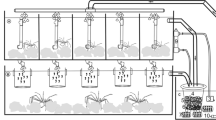Abstract
We measured microhabitat characteristics, hatching and emergence success of brook charr, Salvelinus fontinalis, in a series of sites selected and not selected by individuals spawning in an artificially enhanced lake outlet. Differences between the physico-chemistry of surface and interstitial water were small and did not suggest the presence of groundwater seepage. The mean surface water velocity was significantly higher in selected than non-selected sites during the incubation and emergence periods. Differences in interstitial water flow were not detected. Overall, selected substrate was coarser and contained a lower proportion of fine particles than non-selected substrate, as determined by the geometric mean diameter of particles, the proportion of fine particles (<1 mm), and the Fredle index. The proportion of fine particles was correlated with sediment loading in incubators. A two-way ANOVA showed no significant effect of sites (selected versus non-selected) but did show a significant effect of the incubation substrate (Astro-turf™, selected substrate, non-selected substrate) on both the hatching and emergence success; the percentages of hatching and emergence were significantly higher in Astro-turf™ than in non-selected substrate, with selected substrate being intermediate. The results of this study suggest that redd site selection by brook charr is based on surface water velocity and substrate characteristics (granulometry and proportion of fine particles) that in turn affect egg survival. It is possible that the lower proportion of fine particles in selected sites (and incubators) is related to their higher water velocity, which could carry away fine particles that reduce the availability of oxygenated water to the embryos. In the same way, higher water velocity could act as a proximate cue in the absence of groundwater seepage or interstitial water flow for individuals to select suitable sites for spawning and egg incubation.
Similar content being viewed by others
References cited
Adams, J.N. & R.L. Beschta. 1980. Gravel bed composition in Oregon coastal streams. Can. J. Fish. Aquat. Sci. 37: 1514–1521.
Baril, M. 1999. Écologie et comportement reproducteur de l'omble de fontaine, Salvelinus fontinalis, dans une frayère aménagée. Master's Thesis, Université du Québec à Trois-Rivières, Trois-Rivières. 51 pp.
Baril, M. & P. Magnan. 2002. Seasonal timing and diel activity of lacustrine brook charr, Salvelinus fontinalis, spawning in a lake outlet. Env. Biol. Fish. 64: 175–181 (this volume).
Bernier-Bourgault, I. 2000. Facteurs déterminant la sélection d'un site de fraye ainsi que les succè d'éclosion et d'émergence chez l'omble de fontaine (Salvelinus fontinalis) dans une frayère aménagée. Master's Thesis, Université du Québec à Trois-Rivières, Trois-Rivières. 67 pp.
Blanchfield, P.J. & M.S. Ridgway. 1997. Reproductive timing and use of redd sites by lake-spawning brook trout (Salvelinus fontinalis). Can. J. Fish. Aquat. Sci. 54: 747–756.
Chapman, D.W. 1988. Critical review of variables used to define effects of fines in redds of large salmonids. Trans. Amer. Fish. Soc. 117: 1–21.
Curry, R.A. & D.L.G. Noakes. 1995. Groundwater and the selection of spawning sites by brook trout (Salvelinus fontinalis). Can. J. Fish. Aquat. Sci. 52: 1733–1740.
Curry, R.A., D.L.G. Noakes & G.E. Morgan. 1995. Groundwater and the incubation and emergence of brook trout (Salvelinus fontinalis). Can. J. Fish. Aquat. Sci. 52: 1741–1749.
Essington, T.E., P.W. Sorenson & D.G. Paron. 1998. High rates of redd superimposition by brook trout (Salvelinus fontinalis) and brown trout (Salmo trutta) in a Minnesota stream cannot be explained by habitat availability alone. Can. J. Fish. Aquat. Sci. 55: 2310–2316.
Fraser, J.M. 1982. An atypical brook charr (Salvelinus fontinalis) spawning area. Env. Biol. Fish. 7: 385–388.
Fraser, J.M. 1985. Shoal spawning of brook trout, Salvelinus fontinalis, in a precambrian shield lake. Nat. Can. 112: 163–174.
Guillemette, F. 2001. Déterminants de la sélection des sites de fraye en lac et du succès d'éclosion des œufs chez l'omble de fontaine (Salvelinus fontinalis). Master's Thesis, Université du Québec à Trois-Rivières, Trois-Rivières. 62 pp.
Gunn, J.M. 1986. Behaviour and ecology of salmonid fishes exposed to episodic pH depressions. Env. Biol. Fish. 17: 241–252.
Hausle, D.A. & D.W. Coble. 1976. Influence of sand in redds on survival and emergence of brook trout (Salvelinus fontinalis). Trans. Amer. Fish. Soc. 105: 57–63.
Lachance, S., P. Bérubé & M. Lemieux. 2000. In situ survival and growth of three brook trout strains, Salvelinus fontinalis, subjected to acid conditions of anthropogenic origin at the egg and fingerling stages. Can. J. Fish. Aquat. Sci. 57: 1562–1573.
Lee, D.R. & J.A. Cherry. 1978. A field exercise on groundwater flow using seepage meters and mini-piezometers. J. Geol. Ed. 27: 6–10.
McNeil, W.J. 1967. Randomness in distribution of pink salmon redds. J. Fish. Res. Board Can. 24: 1629–1634.
McNeil, W.J. & W.H. Ahnell. 1960. Measurement of gravel composition of salmon stream beds. Circ. 120, University of Washington, Seattle. 7 pp.
Piper, R.G., I.B. McElwain, L.E. Orme, J.P. McCraren, L.G. Fowler & J.R. Leonard. 1982. Fish hatchery management. U.S. Department of the Interior, Fish and Wildlife Service, Washington. 517 pp.
Smith, A.K. 1973. Development and application of spawning velocity and depth criteria for Oregon salmonids. Trans. Amer. Fish. Soc. 102: 312–316.
Snucins, E.J., R.A. Curry & J.M. Gunn. 1992. Brook trout (Salvelinus fontinalis) embryo habitat and timing of alevin emergence in a lake and a stream. Can. J. Zool. 70: 423–427.
Sokal, R.R. & F.J. Rohlf. 1981. Biometry, 2nd edition. Freeman and Company, San Francisco. 859 pp.
Sowden, T.K. & G. Power. 1985. Prediction of rainbow trout embryo survival in relation to groundwater seepage and particle size of spawning substrates. Trans. Amer. Fish. Soc. 114: 804–812.
Stuart, T.A. 1953. Water currents through permeable gravels and their significance to spawning salmonids. Nature 172: 407–408.
Webster, D.A. & G. Eiriksdottir. 1976. Upwellingwater as a factor influencing choice of spawning sites by brook trout (Salvelinus fontinalis). Trans. Amer. Fish. Soc. 105: 416–421.
White, D.S. 1990. Biological relationships to convective flowpatterns with stream beds. Hydrobiologia 196: 149–158.
Witzel, L.D. & H.R. MacCrimmon. 1983a. Redd-site selection by brook trout and brown trout in southwestern Ontario streams. Trans. Amer. Fish. Soc. 112: 760–771.
Witzel, L.D. & H.R. MacCrimmon. 1983b. Embryo survival and alevin emergence of brook charr, Salvelinus fontinalis, and brown trout, Salmo trutta, relative to redd gravel composition. Can. J. Zool. 61: 1783–1792.
Young, M.K., W.A. Hubert & T.A. Wesche. 1989. Substrate alteration by spawning brook trout in a southeastern Wyoming stream. Trans. Amer. Fish. Soc. 118: 379–385.
Author information
Authors and Affiliations
Corresponding author
Rights and permissions
About this article
Cite this article
Bernier-Bourgault, I., Magnan, P. Factors Affecting Redd Site Selection, Hatching, and Emergence of Brook Charr, Salvelinus Fontinalis, in an Artificially Enhanced Site. Environmental Biology of Fishes 64, 333–341 (2002). https://doi.org/10.1023/A:1016006303854
Issue Date:
DOI: https://doi.org/10.1023/A:1016006303854




